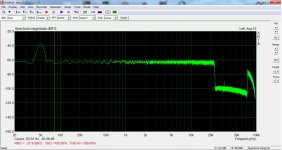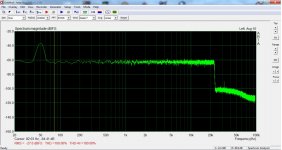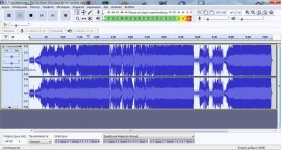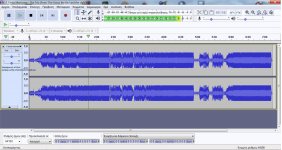Fig.1 shows the May's impulse response with 44.1kHz data in NOS mode. Ignore the very small amount of symmetrical ringing before and after the single full-scale sample, which is due to the antialiasing filter of Audio Precision's A/D converter operating at a sample rate of 200kHz. This graph indicates perfect time-domain behavior due to the absence of a low-pass reconstruction filter.
This DAC should not stop reproducing at 20Khz while processing 96K & 192K incoming signals.
So there is more to be explained than just the AP’s anti alias filter.
I’m sure it is a excellent piece of engineering, but is it a true NOS with no digital filtering ?
I have my doubts.
Hans
...My first NOS DAC was DIY TDA1541 used with Audiomeca Mephisto II CD Transport – this was by far the best analogue-sounding combination I heard. Pure bliss. It had that natural drive, emotion and overall presentation (extension, depth, natural colour of the harmonics) that was so much like analogue records playing on a decent system.
Then I tried dual differential 1704 design (Denon CD player), heavily modified throughout (the best I/V I arrived at was with AD811, which took me a long while to get right). It sounded great, “sophisticated”, but so far behind 1541 and Memphisto combo.
I tried DDDAC with very low noise regulation (I spent a lot of money on it!!!); it did sound great but required 2xOS to get rid off the high-frequency roll-off, and that was just ruining the listening experience for me. So, in pure NOS mode, the high freq. roll-off was an issue for me; with 2xOS –> I was getting just a bit of that metallic flavour…
I realised that DIY-ing will not get me where I wanted to be… so I started listening to various DAC’s at home, auditioning and comparing.
The moment I heard Holo May DAC was the moment I knew that I found what I was searching for all these years. Very natural, pleasant to listen to, able to re-create natural (or at least what I expect to hear…) ambience and harmonics’ richness. In addition, this DAC will also show what OS sounds like (hence, it is perfect to compare NOS vs. either PCM OS or DSD) – and it will handle anything and everything one can think of… certain HQ Plyer OS/dither/filters’ PCM combination, and certain DSD modulators/filters combinations will sound impressive (it seems that the sound is better than original!), but will all exhibit that metallic flavour.
I get the most listenable results with JRiver with its DSP disabled, playing raw (native resolution) files. And I do not get that feel of high freq. roll-off; actually, I feel so much top extension in NOS mode which is simply unbelievable (against all my previous experience) and the main reason why I got this DAC.
One thing I realised when I listened to Holo May DAC in NOS was how close its sound character matched the DDDAC – it was unbelievable. So, there’s something about NOS…
Audioscience Review has May’s NOS, PCM and DSD filters’ response plots.
So, it seems to me at least, that the minimum amount of DSP, coupled with letting a bit of hat ultrasonic noise through (no de-glitchers/steep, complicated / phase-relationship-ruining analog filters) is the best recipe
Thank you, for that report. It seems as though NOS + 20KHz droop EQ always rises to the top of enjoyable DAC playback for you. Which makes a great deal of sense.
Our end goal is to determine whether and how, it may be possible to combine the desireable characteristics of NOS sound, with the desireable aspects of OS sound which some us hear. One possible solution may be to add a high-order analog reconstruction filter to the output of a NOS DAC. Which is the reason for our interest in comparing NOS DAC sound without any output filter, versus the sound with a high-order output filter.
My DAC produces a measured 2.7uVrms output over 20Khz BW.
This translates into 19nV/rtHz.
With two LT1468 producing 7nv/rtHz and one OPA1632 producing ca 5nV/rtHz including 1K feedback resistors, total noise contribution is 9nV/rtHz, leaving some 17nV/rtHz for PCM 1792, or 10nV/rtHz per individual output.
So yes, that means that a fast Fet amp (opa1642?) can do the job perfectly.
Hans
It isn't clear if the effects of noise is relevant if considered as a separate entity to signal, other than becoming of ratio-metric audibility by using a digital volume control reducing bit depth. In other words the noise levels seem far below audibility if listened to on their own. Hence it only seems relevant if noise can cause signal distortions or artifacts greater in amplitude than the amplitude contribution of the noise itself. This is is suspected what might occur in limited bandwidth feedback networks, and whereupon there seems must exist some form of rectification process (predominance of some form of single sided transient non-linearity) for signals to be reflected back down into the audio band. Is this what you are suggesting?
Hi Ken,
I can't operate the nos dac without the filter attached. Some folks have the same dac with a 3rd order filter and have reported that the 3rd order sounds different than the 7th order. Perhaps Richard can chime it, he knows best.
Paul
Paul, I've somehow managed to overlook asking you the most obvious questions.
What is your subjective assessment of the sound of your PhiDAC's NOS playback via Richard's 7th order passive filter? And it versus the playback of other DACs (OS or NOS) which you may have owned or auditioned?
Perhaps I don't understand your query but anyway, here is what I capture from my NOS DAC with white noise created with audacity and then extracted as flac at 44,1 96 and 192kHz.This DAC should not stop reproducing at 20Khz while processing 96K & 192K incoming signals.
So there is more to be explained than just the AP’s anti alias filter.
I’m sure it is a excellent piece of engineering, but is it a true NOS with no digital filtering ?
I have my doubts.
Hans
Attachments
Intersample overshoots
First with original test signals. The first signal measures the same in both OS and NOS and sounds just a bit louder in OS. The second signal -first pic- measures and sounds different. OS is yellow, NOS is green. Distortion can be easily heard.
Then with levels halved. No measurable difference - second pic. Both signals sound a bit louder in OS. All in all, as expected.
Finally the next logical step. I processed the aforementioned track with the trumpet with audacity to reduce level by 6dB. Vibrato was just a bit more dynamic in OS than before but in NOS got worse. Both modes now come closer but in the wrong way, so I don't feel this is the way to go. I attach screenshots of the file before and after processing. The original seems like compressed but it doesn't sound so. I think it hits zero without clipping. The processed file sounds compressed if this makes sense to you...
First with original test signals. The first signal measures the same in both OS and NOS and sounds just a bit louder in OS. The second signal -first pic- measures and sounds different. OS is yellow, NOS is green. Distortion can be easily heard.
Then with levels halved. No measurable difference - second pic. Both signals sound a bit louder in OS. All in all, as expected.
Finally the next logical step. I processed the aforementioned track with the trumpet with audacity to reduce level by 6dB. Vibrato was just a bit more dynamic in OS than before but in NOS got worse. Both modes now come closer but in the wrong way, so I don't feel this is the way to go. I attach screenshots of the file before and after processing. The original seems like compressed but it doesn't sound so. I think it hits zero without clipping. The processed file sounds compressed if this makes sense to you...
Attachments
Hi Ken,Paul, I've somehow managed to overlook asking you the most obvious questions.
What is your subjective assessment of the sound of your PhiDAC's NOS playback via Richard's 7th order passive filter? And it versus the playback of other DACs (OS or NOS) which you may have owned or auditioned?
Subjectively I'd have to say it sounds more relaxed, with less glare in the higher frequencies. The phidac has been corrected for the nos droop so the information is there, just presented differently. A lot of os dacs can sound glassy in high frequency, like the ESS offerings that I own. I'd also say that to me the os dacs can sound a bit more dynamic than nos. Vocals stand out as being more realistic and having more nuance with nos. Could be a timing thing, less smear with the data. Nos sounds closer to my vinyl, but still different, certainly cleaner.
I can't operate the nos dac without the filter attached. Some folks have the same dac with a 3rd order filter and have reported that the 3rd order sounds different than the 7th order. Perhaps Richard can chime it, he knows best.
Bypassing the passive filter would need a couple of short wires (or 0R resistors) soldering onto the baseboard and removal of the filter board. Its not something I've tried so far but I don't think the mod is likely to damage anything.
If anyone wants to try it, I'll produce a graphic for what to do.
Perhaps I don't understand your query but anyway, here is what I capture from my NOS DAC with white noise created with audacity and then extracted as flac at 44,1 96 and 192kHz.
Using noise is a perfect way to get the Frequence Response.
But the noise you produced was bandlimited to 20Khz for all three cases.
The first picture shows a FR to 20Khz, the rest of the 44.1 spectrum are images exactly as expected, so far so good.
Now try to produce noise limited at resp ca 40Khz and 80Khz for the two higher sampling rates.
You will then see the spectrum of the reproduced 96Khz file going to 40Khz and starting again as mirror as from 56Khz and for 192Khz going to 80Khz and starting again as from 112Khz as mirror.
However the Holo May stops in all cases reproducing at 20Khz which seems in this very case to be caused by digital filtering.
Hans
Could you send (part of) your track as a .Wav file ?I processed the aforementioned track with the trumpet with audacity to reduce level by 6dB. Vibrato was just a bit more dynamic in OS than before but in NOS got worse. Both modes now come closer but in the wrong way, so I don't feel this is the way to go. I attach screenshots of the file before and after processing. The original seems like compressed but it doesn't sound so. I think it hits zero without clipping. The processed file sounds compressed if this makes sense to you...
That the NOS sound gets compressed after attenuation seems to make no sense.
Only the S/N is supposed to worsen by 6dB, but I can imagine that your OS process gets overloaded.
Hans
Holo May stops in all cases reproducing at 20Khz which seems in this very case to be caused by digital filtering.
Hans
Review and Measurements of Holo Audio May --- Probably the best discrete R2R DAC | Audio Science Review (ASR) Forum
Last edited:
This DAC should not stop reproducing at 20Khz while processing 96K & 192K incoming signals.
So there is more to be explained than just the AP’s anti alias filter.
I’m sure it is a excellent piece of engineering, but is it a true NOS with no digital filtering ?
I have my doubts.
Hans
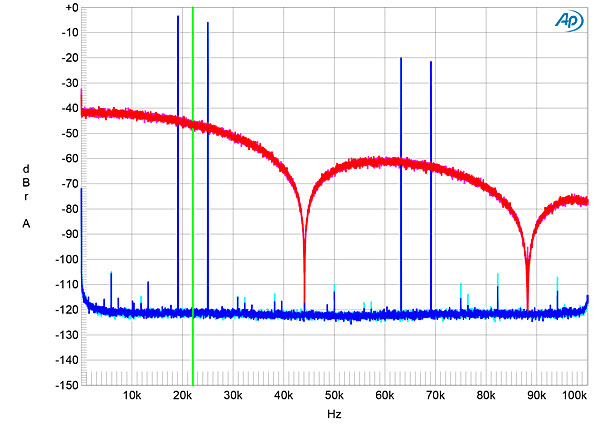
John Atkinson Stereophile measurements above show Holo May DAC in NOS mode has no filtering. So I dont follow your doubts?
For comparison Denafrips in NOS below:
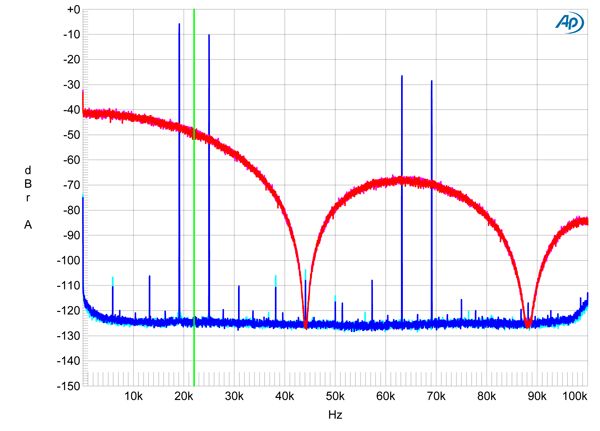
These images show that there is no analoque filter being used at 44.1, see the red line.
It would have been nice to also show this noise at 96K and 192K.
But read the Stereophile review and you will see that at 96K and 192k signal reproduction stops at 20Khz instead of at 96/2 and 192/2 as should be the case with NOS.
Hans
It would have been nice to also show this noise at 96K and 192K.
But read the Stereophile review and you will see that at 96K and 192k signal reproduction stops at 20Khz instead of at 96/2 and 192/2 as should be the case with NOS.
Hans
I’m not attacking this design and already complimented the fantastic reproduction of a -90.3 dBfs input signal.
My only comment is that I have a problem in believing that the NOS mode is really NOS for 96K and 192K.
Hans
Agreed! I was just thinking they may used bandlimited signal to resemble music files.Using noise is a perfect way to get the Frequence Response.
But the noise you produced was bandlimited to 20Khz for all three cases.
The first picture shows a FR to 20Khz, the rest of the 44.1 spectrum are images exactly as expected, so far so good.
Now try to produce noise limited at resp ca 40Khz and 80Khz for the two higher sampling rates.
You will then see the spectrum of the reproduced 96Khz file going to 40Khz and starting again as mirror as from 56Khz and for 192Khz going to 80Khz and starting again as from 112Khz as mirror.
However the Holo May stops in all cases reproducing at 20Khz which seems in this very case to be caused by digital filtering.
Hans
Me too, I was not expecting any difference in dynamic range but I had this impression... Unfortunately, the forum provides a very low limit to allow uploading lossless files... Even a few seconds seems too much. Could you suggest an alternative way?Could you send (part of) your track as a .Wav file ?
That the NOS sound gets compressed after attenuation seems to make no sense.
Only the S/N is supposed to worsen by 6dB, but I can imagine that your OS process gets overloaded.
Hans
....read the Stereophile review and you will see that at 96K and 192k signal reproduction stops at 20Khz instead of at 96/2 and 192/2 as should be the case with NOS.
Hans
I missed that. I wonder if you can please post the info?
If a DAC doesn't actually over sample a high rate but uses a digital filter to suppress ultrasonic noise I guess its still technically non oversampled?
Coming back on I/V conversion.
In post #472 I calculated a 17nV/rtHz for the noise contribution of the 1792 / 1794.
This translates into a theoretical S/N when output is 2Vrms of 20*log(2/(141*17e-9)) = 121.6 dB.
With low noise amps for an active conversion, it is possible to stay quite close to this figure.
However, the question is, do we need such a huge S/N ?
Reason to ask this question is because when resorting to a passive I/V things will be changed quite a bit.
Assume a 10R resistor is used with a par. cap, then with the +/- 4mA that the Dac can supply, we will need 71*gain to get the same 2Vrms output.
Even with very low noise amps resulting like in total 6nV/rtHz, S/N for 20Khz BW will now be 20*log(2/(141*6e-9*71) = 90.4dB.
So more than 30dB is lost by going to passive I/V.
However comparing this to phono reproduction, 75dBA or ca 70dB is regarded as sufficient, although LP’s can go at least 10dB above 0dB where a CD has a very hard limit at 0dB .
Taking this into account, my feeling is that 90dB for digital reproduction is still acceptabe.
The advantage of a passive I/V is that it is perfectly linear whereas the input of an active converter can become overloaded resulting in distortion, even when BW and slew rate seem to be high enough.
The point is however that a current Dac can only produce very low voltages before getting non linear, that’s why this resistor should have a very low value like 10R.
Reactions are welcome from those using a passive I/V conversion on the subject of S/N and on the sound quality compared to active conversion.
Hans
In post #472 I calculated a 17nV/rtHz for the noise contribution of the 1792 / 1794.
This translates into a theoretical S/N when output is 2Vrms of 20*log(2/(141*17e-9)) = 121.6 dB.
With low noise amps for an active conversion, it is possible to stay quite close to this figure.
However, the question is, do we need such a huge S/N ?
Reason to ask this question is because when resorting to a passive I/V things will be changed quite a bit.
Assume a 10R resistor is used with a par. cap, then with the +/- 4mA that the Dac can supply, we will need 71*gain to get the same 2Vrms output.
Even with very low noise amps resulting like in total 6nV/rtHz, S/N for 20Khz BW will now be 20*log(2/(141*6e-9*71) = 90.4dB.
So more than 30dB is lost by going to passive I/V.
However comparing this to phono reproduction, 75dBA or ca 70dB is regarded as sufficient, although LP’s can go at least 10dB above 0dB where a CD has a very hard limit at 0dB .
Taking this into account, my feeling is that 90dB for digital reproduction is still acceptabe.
The advantage of a passive I/V is that it is perfectly linear whereas the input of an active converter can become overloaded resulting in distortion, even when BW and slew rate seem to be high enough.
The point is however that a current Dac can only produce very low voltages before getting non linear, that’s why this resistor should have a very low value like 10R.
Reactions are welcome from those using a passive I/V conversion on the subject of S/N and on the sound quality compared to active conversion.
Hans
No JA did not and was surprised by the outcome.Agreed! I was just thinking they may used bandlimited signal to resemble music files.
Me too, I was not expecting any difference in dynamic range but I had this impression... Unfortunately, the forum provides a very low limit to allow uploading lossless files... Even a few seconds seems too much. Could you suggest an alternative way?
You could use dropbox or wetransfer, both freeware.
Did you add dither after having reduced the level by 6dB?
Hans
I missed that. I wonder if you can please post the info?
If a DAC doesn't actually over sample a high rate but uses a digital filter to suppress ultrasonic noise I guess its still technically non oversampled?
No, the contrary, it will be downsampled.
Here’s JA text
Fig.7 shows the May's frequency response in NOS mode with data sampled at 44.1, 96, and 192kHz. All three responses start rolling off in the top two audio octaves. With 44.1kHz data (green and gray data), the rolloff reaches –1.5dB at the top of the audioband, but the measured level is adulterated with aliased image energy. The actual rolloff is probably closer to –3dB at 20kHz (see fig.16). The response at the higher sample rates is down by 1dB at 19kHz (96kHz data, cyan and magenta traces) and 22kHz (192kHz data, blue and red traces). The response with 44.1kHz data in OS and OS/PCM modes (fig.8, green and gray traces) is –0.65dB at 20kHz, with then a sharp rolloff. With data at the higher sample rates, the response features a relatively gentle ultrasonic rolloff, but the 192kHz response (blue and red traces) doesn't extend significantly higher in frequency than that with 96kHz data (cyan and magenta traces). Even with 192kHz PCM data, the May's response in OS/DSD mode (fig.9, blue and red traces) rolled off sharply above 20kHz.
my feeling is that 90dB for digital reproduction is still acceptable.
I don't even know any mic/mic preamp combo that can actualy get that kind of dynamic range.
- Home
- Source & Line
- Digital Line Level
- What do you think makes NOS sound different?

